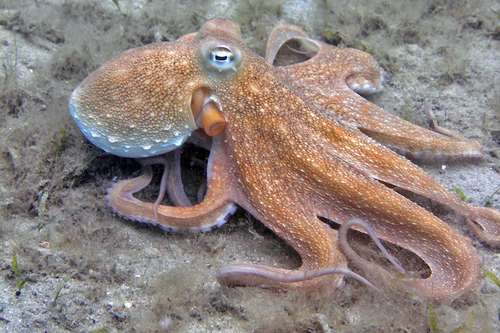
Description:
Scientific Name: Octopus rubescens
Lifespan: About 2 years
O.rubescens, like all octopuses, may alter its colour and texture, giving it a highly changeable look. Deep brick white, red, brown, or mottled variations of those colors are all possible. Three eyelash-like papillae that are present underneath the eyes of O. rubescens but are lacking in E. dofleini serve as a distinguishing feature between the two species.
Ocelli absent; papillate skin, frequently with cirri; arms nearly four times the length of the body; sixth pairs of suckers increased on all male arms save the ventral arms; ink reddish brown; eggs small (3-4 mm x 1.5-2 mm); capsules with long stalks twisted into cords; placed in festoons. elaborate head, eyes that create a camera-like image, a highly developed nerve system, and as a result, sophisticated behavior. is predatory and extremely mobile. The muscle syphon used in jet propulsion is rolled into by their foot. The beaked mouth is surrounded by grasping arms. Typically, the shell is little or nonexistent. An extensive closed circulatory system transports blood.
Habitat
On much of the West Coast of North American, Octopus rubescens is the most often encountered shallow-water octopus and a common benthic predator in these environments. It can be found in the western Pacific Ocean. O. rubescens can be found 300 m below in the intertidal zone.

Behavior
Although they favour small crabs and hermit crabs, octopus rubescens is thought to forage at night and consume a variety of gastropods, crustaceans, euphausiids, bivalves, and even fish.
O. rubescens will pounce on prey as part of its feeding behavior, and during the time of capture, it will exhibit a stereotypical series of colour changes. It frequently drills a hole through the shell of its bivalve victim after capturing it in order to inject venom and make the shell easier to open. The octopuses frequently focus their drilling efforts close to the bivalve prey’s adductor muscles..
Keeping as a Pet/ In Captivity
It eats a range of gastropods, crabs, bivalves, crustaceans, fish, and other mollusks, making it somewhat of a generalist. Sand and rocks make up the substrate in the tank where O. rubescens is growing.
Table





